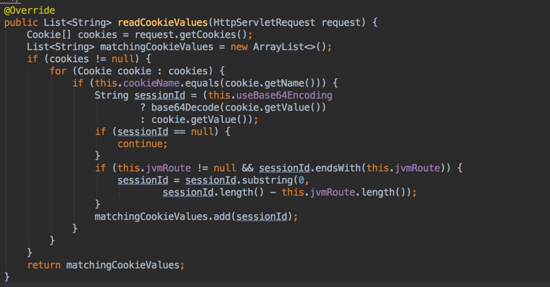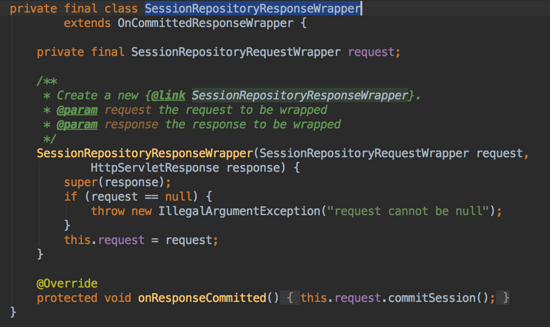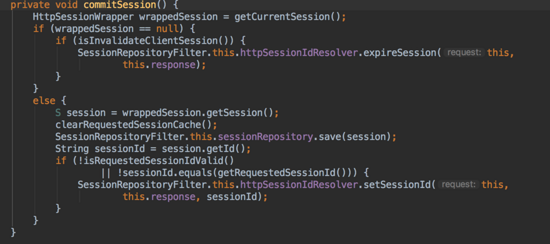您好,登錄后才能下訂單哦!
您好,登錄后才能下訂單哦!
本篇文章為大家展示了使用SpringSession怎么實現請求與響應重寫,內容簡明扼要并且容易理解,絕對能使你眼前一亮,通過這篇文章的詳細介紹希望你能有所收獲。
1、請求重寫
SpringSession 中對于請求重寫,在能力上主要體現在存儲方面,也就是 getSession 方法上。在 SessionRepositoryFilter 這個類中,是通過內部類的方式實現了對 HttpServletRequset 和 HttpServletResponse 的擴展。
1.1 HttpServletRequset 擴展實現
private final class SessionRepositoryRequestWrapper
extends HttpServletRequestWrapper {
// HttpServletResponse 實例
private final HttpServletResponse response;
// ServletContext 實例
private final ServletContext servletContext;
// requestedSession session對象
private S requestedSession;
// 是否緩存 session
private boolean requestedSessionCached;
// sessionId
private String requestedSessionId;
// sessionId 是否有效
private Boolean requestedSessionIdValid;
// sessionId 是否失效
private boolean requestedSessionInvalidated;
// 省略方法
}1.2 構造方法
private SessionRepositoryRequestWrapper(HttpServletRequest request,
HttpServletResponse response, ServletContext servletContext) {
super(request);
this.response = response;
this.servletContext = servletContext;
}構造方法里面將 HttpServletRequest 、 HttpServletResponse 以及 ServletContext 實例傳遞進來,以便于后續擴展使用。
1.3 getSession 方法
@Override
public HttpSessionWrapper getSession(boolean create) {
// 從當前請求線程中獲取 session
HttpSessionWrapper currentSession = getCurrentSession();
// 如果有直接返回
if (currentSession != null) {
return currentSession;
}
// 從請求中獲取 session,這里面會涉及到從緩存中拿session的過程
S requestedSession = getRequestedSession();
if (requestedSession != null) {
// 無效的會話id(不支持的會話存儲庫)請求屬性名稱。
// 這里看下當前的sessionId是否有效
if (getAttribute(INVALID_SESSION_ID_ATTR) == null) {
// 設置當前session的最后訪問時間,用于延遲session的有效期
requestedSession.setLastAccessedTime(Instant.now());
// 將requestedSessionIdValid置為true
this.requestedSessionIdValid = true;
// 包裝session
currentSession = new HttpSessionWrapper(requestedSession, getServletContext());
// 不是新的session,如果是新的session則需要改變sessionId
currentSession.setNew(false);
// 將session設置到當前請求上下文
setCurrentSession(currentSession);
// 返回session
return currentSession;
}
}
else {
// 這里處理的是無效的sessionId的情況,但是當前請求線程 session有效
if (SESSION_LOGGER.isDebugEnabled()) {
SESSION_LOGGER.debug(
"No session found by id: Caching result for getSession(false) for this HttpServletRequest.");
}
// 將invalidSessionId置為true
setAttribute(INVALID_SESSION_ID_ATTR, "true");
}
// 是否需要創建新的session
if (!create) {
return null;
}
if (SESSION_LOGGER.isDebugEnabled()) {
SESSION_LOGGER.debug(
"A new session was created. To help you troubleshoot where the session was created we provided a StackTrace (this is not an error). You can prevent this from appearing by disabling DEBUG logging for "
+ SESSION_LOGGER_NAME,
new RuntimeException(
"For debugging purposes only (not an error)"));
}
// 創建新的session
S session = SessionRepositoryFilter.this.sessionRepository.createSession();
// 設置最后訪問時間,也就是指定了當前session的有效期限
session.setLastAccessedTime(Instant.now());
// 包裝下當前session
currentSession = new HttpSessionWrapper(session, getServletContext());
//設置到當前請求線程
setCurrentSession(currentSession);
return currentSession;
}上面這段代碼有幾個點,這里單獨來解釋下。
getCurrentSession
這是為了在同一個請求過程中不需要重復的去從存儲中獲取session,在一個新的進來時,將當前的 session 設置到當前請求中,在后續處理過程如果需要getSession就不需要再去存儲介質中再拿一次。
getRequestedSession
這個是根據請求信息去取 session ,這里面就包括了 sessionId 解析,從存儲獲取 session 對象等過程。
是否創建新的 session 對象
在當前請求中和存儲中都沒有獲取到 session 信息的情況下,這里會根據 create 參數來判斷是否創建新的 session 。這里一般用戶首次登錄時或者 session 失效時會走到。
1.4 getRequestedSession
根據請求信息來獲取 session 對象
private S getRequestedSession() {
// 緩存的請求session是否存在
if (!this.requestedSessionCached) {
// 獲取 sessionId
List<String> sessionIds = SessionRepositoryFilter.this.httpSessionIdResolver
.resolveSessionIds(this);
// 通過sessionId來從存儲中獲取session
for (String sessionId : sessionIds) {
if (this.requestedSessionId == null) {
this.requestedSessionId = sessionId;
}
S session = SessionRepositoryFilter.this.sessionRepository
.findById(sessionId);
if (session != null) {
this.requestedSession = session;
this.requestedSessionId = sessionId;
break;
}
}
this.requestedSessionCached = true;
}
return this.requestedSession;
}這段代碼還是很有意思的,這里獲取 sessionId 返回的是個列表。當然這里是 SpringSession 的實現策略,因為支持 session ,所以這里以列表的形式返回的。OK,繼續來看如何解析 sessionId 的:

這里可以看到 SpringSession 對于 sessionId 獲取的兩種策略,一種是基于 cookie ,一種是基于 header ;分別來看下具體實現。
1.4.1 CookieHttpSessionIdResolver 獲取 sessionId
CookieHttpSessionIdResolver 中獲取 sessionId 的核心代碼如下:

其實這里沒啥好說的,就是讀 cookie 。從 request 將 cookie 信息拿出來,然后遍歷找當前 sessionId 對應的 cookie ,這里的判斷也很簡單, 如果是以 SESSION 開頭,則表示是 SessionId ,畢竟 cookie 是共享的,不只有 sessionId,還有可能存儲其他內容。
另外這里面有個 jvmRoute,這個東西實際上很少能夠用到,因為大多數情況下這個值都是null。這個我們在分析 CookieSerializer 時再來解釋。
1.4.2 HeaderHttpSessionIdResolver 獲取 sessionId

這個獲取更直接粗暴,就是根據 headerName 從 header中取值。
回到 getRequestedSession ,剩下的代碼中核心的都是和 sessionRepository 這個有關系,這部分就會涉及到存儲部分。不在本篇的分析范圍之內,會在存儲實現部分來分析。
1.5 HttpSessionWrapper

上面的代碼中當我們拿到 session 實例是通常會包裝下,那么用到的就是這個 HttpSessionWrapper 。
HttpSessionWrapper 繼承了 HttpSessionAdapter ,這個 HttpSessionAdapter 就是將SpringSession 轉換成一個標準 HttpSession 的適配類。 HttpSessionAdapter 實現了標準 servlet 規范的 HttpSession 接口。
1.5.1 HttpSessionWrapper
HttpSessionWrapper 重寫了 invalidate 方法。從代碼來看,調用該方法產生的影響是:
requestedSessionInvalidated 置為 true ,標識當前 session 失效。
將當前請求中的 session 設置為 null ,那么在請求的后續調用中通過 getCurrentSession 將拿不到 session 信息。
當前緩存的 session 清楚,包括sessionId,session實例等。
刪除存儲介質中的session對象。
1.5.2 HttpSessionAdapter
SpringSession 和標準 HttpSession 的配置器類。這個怎么理解呢,來看下一段代碼:
@Override
public Object getAttribute(String name) {
checkState();
return this.session.getAttribute(name);
}對于基于容器本身實現的 HttpSession 來說, getAttribute 的實現也是有容器本身決定。但是這里做了轉換之后, getAttribute 將會通過 SpringSession 中實現的方案來獲取。其他的 API 適配也是基于此實現。
SessionCommittingRequestDispatcher
實現了 RequestDispatcher 接口。關于 RequestDispatcher 可以參考這篇文章【Servlet】關于RequestDispatcher的原理 。 SessionCommittingRequestDispatcher 對 forward 的行為并沒有改變。 對于 include 則是在 include 之前提交 session 。為什么這么做呢?
因為 include 方法使原先的 Servlet 和轉發到的 Servlet 都可以輸出響應信息,即原先的 Servlet 還可以繼續輸出響應信息;即請求轉發后,原先的 Servlet 還可以繼續輸出響應信息,轉發到的 Servlet 對請求做出的響應將并入原先 Servlet 的響應對象中。
所以這個在 include 調用之前調用 commit ,這樣可以確保被包含的 Servlet 程序不能改變響應消息的狀態碼和響應頭。
2 響應重寫
響應重寫的目的是確保在請求提交時能夠把session保存起來。來看下 SessionRepositoryResponseWrapper 類的實現:

這里面實現還就是重寫 onResponseCommitted ,也就是上面說的,在請求提交時能夠通過這個回調函數將 session
保存到存儲容器中。
2.1 session 提交
最后來看下 commitSession

這個過程不會再去存儲容器中拿 session 信息,而是直接從當前請求中拿。如果拿不到,則在回寫 cookie 時會將當前 session 對應的 cookie 值設置為空,這樣下次請求過來時攜帶的 sessionCookie 就是空,這樣就會重新觸發登陸。
如果拿到,則清空當前請求中的 session 信息,然后將 session 保存到存儲容器中,并且將 sessionId 回寫到 cookie 中。
上述內容就是使用SpringSession怎么實現請求與響應重寫,你們學到知識或技能了嗎?如果還想學到更多技能或者豐富自己的知識儲備,歡迎關注億速云行業資訊頻道。
免責聲明:本站發布的內容(圖片、視頻和文字)以原創、轉載和分享為主,文章觀點不代表本網站立場,如果涉及侵權請聯系站長郵箱:is@yisu.com進行舉報,并提供相關證據,一經查實,將立刻刪除涉嫌侵權內容。